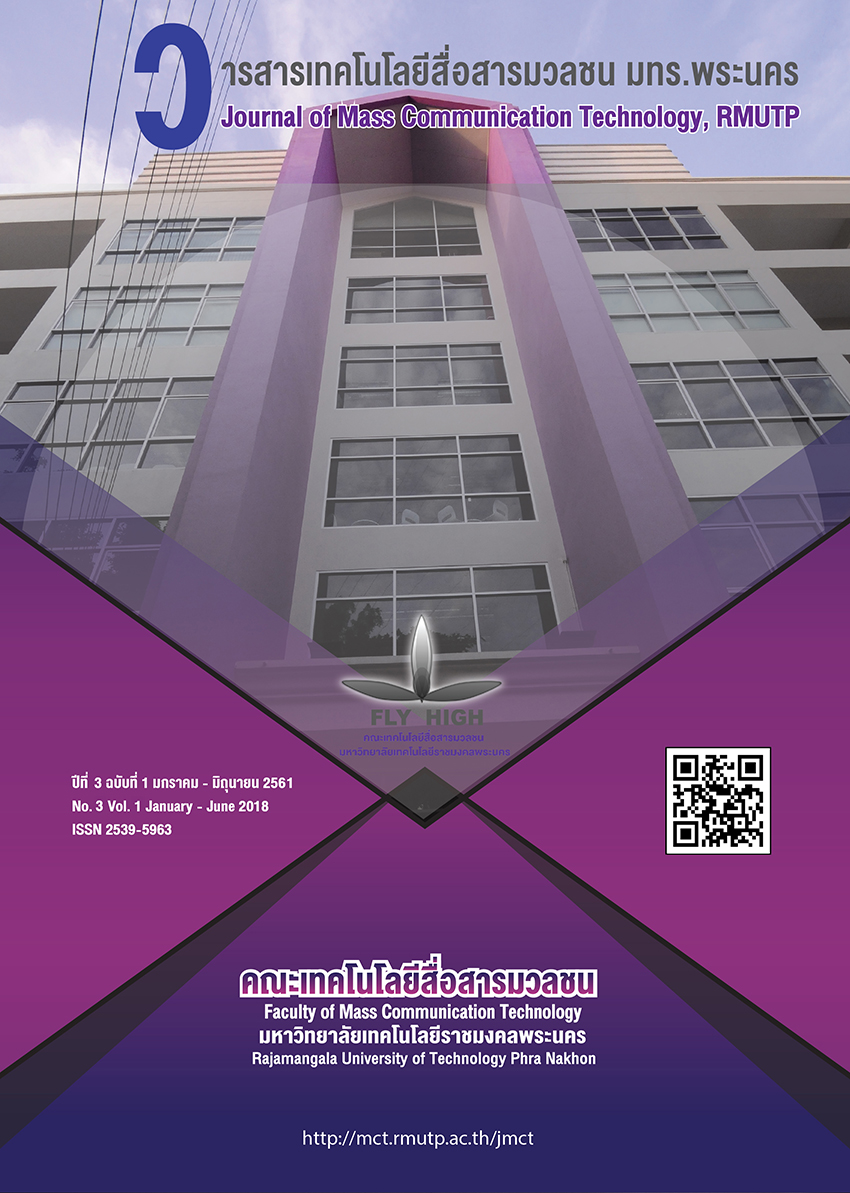การเสริมสร้างทักษะความเข้าใจและใช้เทคโนโลยีดิจิทัลสำหรับเจนเนอเรชั่นซี โดยการเล่าเรื่องด้วยสื่อดิจิทัล
คำสำคัญ:
เจนเนอร์เรชันซี, ชุมชนการเรียนรู้สร้างสรรค์, การรู้เท่าทันดิจิทัล, การเล่าเรื่องแบบดิจิทัลบทคัดย่อ
บทความนี้ได้รายงานผลการพัฒนารูปแบบการเรียนรู้เพื่อเสริมสร้างทักษะความเข้าใจ และใช้เทคโนโลยีดิจิทัล สำหรับเจนเนอเรชันซี (Z) ด้วยการเล่าเรื่องด้วยสื่อดิจิทัล โดยมีวัตถุประสงค์ในการศึกษา คือ 1) เพื่อพัฒนา 2) เพื่อประเมินและรับความคิดเห็นของผู้เชี่ยวชาญเกี่ยวกับรูปแบบการเรียนรู้ รูปแบบการเรียนรู้นี้ประกอบด้วย 6 ขั้นตอนสำคัญ ได้แก่ 1) การคิดริเริ่มและค้นหาข้อมูล 2) การกำหนดรูปแบบและการออกแบบ และการจัดการและการผลิต 3) การเลือกเทคโนโลยีและสื่อ 4) การเขียนและจัดทำบท และการเขียนกรอบแสดงเรื่องราว 5) การรวบรวมสื่อ การสร้าง และการจัดการและการผลิตสื่อ 6) การส่งออกให้แก่ผู้รับสาร และเหตุผลในการปรับเปลี่ยนงานตามคำแนะนำ และการประเมินผลจากผู้รับสาร งานวิจัยนี้จัดทำโดยใช้วิธีวิจัยเชิงคุณภาพ โดยผ่านการประเมินรูปแบบการเรียนรู้จากผู้เชี่ยวชาญ 8 ท่าน โดยการประเมินผลผ่านระบบออนไลน์ ใช้เกณฑ์การประเมิน 5 ระดับ ของ Likert Scale ซึ่งผู้เชี่ยวชาญทั้งหมดได้เห็นตรงกันว่า รูปแบบการเรียนรู้ด้วยการเล่าเรื่องด้วยสื่อดิจิทัล เพื่อเสริมสร้างทักษะความเข้าใจ และใช้เทคโนโลยีดิจิทัล สำหรับเจนเนอเรชันซี นี้มีความเหมาะสม โดยมีผลการประเมินอยู่ในระดับ “มีความเหมาะสมมาก” (=4.39, S.D.=0.60)
เอกสารอ้างอิง
Available from https://issuu.com/adaybulletin/docs/adb431.
Barth, R. (1990). Improving School from Within. San Francisco : Jossey-Bass Publishers.
Bloom, B. (1956). Taxonomy of educational objectives: The classification of educational goals.
Deakin University Library (2014) [Online]. Deakin University Digital Literacy Framework. Available from http://www.deakin.edu.au/__data/assets/pdf_file/ 0008/268748/DL_framework_2014-CC_rev-_2015.pdf
Deutsche Bank (2014). [Online]. Industry 4.0 : Upgrading of Germany’s industrial capabilities on the horizon. Available from: https://www.dbresearch.com/PROD/DBR_INTERNET_EN-PROD/PROD0000000000333571.pdf
Fort, A. (2014). [Online]. 4 Advantages of Cloud-based Technologies in the Classroom. EdTechReview. Available from http://edtechreview.in/e-learning/1235-4-advantages-of-cloud-based-technologies-in-the-classroom
Fung, Y.H. (2004). [Online]. Collaborative online learning: Interaction patterns and limiting factors. Open Learning, 19(2), 54-72. Available from http://dx.doi/10.1080/0268051042000224743
Griffith, E. (2016). [Online]. What is Cloud Computing? Available from http://www.pcmag.com/article2/0,2817,2372163,00.asp
Honey, P. & Mumford, A. (1986). [Online]. The Manual of Learning Styles, Peter Honey Associates. Available from http://www.open.edu/openlearn/ocw/pluginfile.php/629607/
mod_resource /content/1/t175_4_3.pdf
IBM (2017). [Online]. What is Cloud Computing? Available from https://www.ibm.com/cloud-computing/learn-more/what-is-cloud-computing/
Kajder, S. (2004). [serial online]. Enter here : Personal narrative and digital storytelling. The English Journal, 93 : 64-68. Available from http://www.jstor.org/stable/4128811?seq=1&cid=pdf-reference#references_tab_contents
Karpati, A. (2011). [serial online]. Digital literacy in education. UNESCO Institute for Information Technologies in Education. Moscow : Russia (2011). Available from http://www.sciencedirect.com/science/article/pii/S2452315116301254#bbib15
Lave, J., & Wenger, E. (1990). Situated learning: Legitimate peripheral participation. Cambridge, UK: Cambridge University Press.
Leslie, R. (2010). [Online]. Digital Storytelling: Never Has Storytelling Been So Easy or So Powerful. Knowl Quest 38 no4 Mr/Ap 2010 56-7. Available from https://ilawiki.wikispaces.com/file/view/Digital+storytelling+article.pdf
Lifelong Kindergarten Group at the MIT Media Lab (n.d.). About Scratch. Available from https://scratch.mit.edu/about/.
Malita, L. & Martin, C. (2010). [Online]. Digital Storytelling as web passport to success in the 21st Century. Procedia Social and Behavioral Sciences, 2, 3060–3064. Available from http://www.sciencedirect.com/science/article/pii/S1877042810005057
McCrindle (2015). [Online]. Characteristics of the emerging generation, McCrindle. Available from http://mccrindle.com.au/the-mccrindle-blog/gen-z-and-gen-alpha-infographic-update
Mendosa, M. (2015). [Online]. The Evolution of Storytelling. Available from http://reporter.rit.edu/tech/evolution-storytelling.
Morra, S. (2014). [Online]. 8 Steps to Great Digital Storytelling. Available from http://edtechteacher.org/8-steps-to-great-digital-storytelling-from-samantha-on-edudemic/
Nonaka, I. & Takeuchi, H. (1995). [Online]. The Nonaka and Takeuchi Knowledge Spiral Model.
Available from http://www.tlu.ee/~sirvir/IKM/Theoretical_models_of_Information_and_
Knowledge _Management/the_nonaka_and_takeuchi_knowledge_spiral_model.html
Ng, W., Nicholas, H., & Williams, A. (2010). School experience influences on pre-service teachers' evolving beliefs about effective teaching. Teaching and Teacher Education, 26(2), 278-289. Available from http://dx.doi.org/10.1016/j.tate.2009.03.010
Papert, S. (1991). Situating constructionism. In I. Harel, & S. Papert (Eds.), Constructionism: Research reports and essays, 1985-1990. Norwood, NJ: Ablex.
Partnership for 21st Century Learning (n.d.). Framework for 21st Century Learning. Available from: http://www.p21.org/our-work/p21-framework
Piaget, J. (1955). The construction of reality in the child. London: Routledge Keegan Paul
Prensky, M. (2001). [Online]. From Digital Game-Based Learning. New York : McGraw-Hill. Available from http://www.marcprensky.com/writing/Prensky%20-%20Ch1-Digital%20Game Based%20Learning.pdf
Siemen, G. (2005). [Online]. Connectivism: A Learning Theory for the Digital Age. International Journal of Instructional Technology and Distance Learning. Available from http://www.itdl.org/journal/jan_05/article01.htm
Singh. A. (2014). [serial online]. Challenges and Issues of Generation Z. IOSR Journal of Business and Management, 16, 59-63. Available from http://www.iosrjournals.org
Standley, M. (2003). Digital Storytelling - Using new technology and the power of stories to help our students learn—and teach. [Cable in the Classroom.] Available from https://msu.edu/~nienhou5/DigitalStorytellingSIG/Benefits_files /Mark%20Standley.pdf
Suppasetseree, S. (2005). [Online]. The development of an internet-based instructional system for teaching remedial English to first-year university students. Thailand, Suranaree University of Technology. Available from http://sutir.sut.ac.th:8080/sutir/bitstream/123456789/1714/2/suksan_fulltext.pdf
UNESCO Institute for Information Technologies in Education Policy Brief. (2011). [Online]. Digital Literacy in Education, Policy Brief. Available from http://unesdoc.unesco.org/images/0021/002144/214485e.pdf
University of Houston (2017). [Online]. What is Digital Storytelling? Available from http://digitalstorytelling.coe.uh.edu/page.cfm?id=27&cid=27
Vygotsky, L. (1978). Interaction between learning and development. Readings on the development of children, 23(3), 34-41.
World Economic Forum. (2015). [Online]. The Global Competitiveness Report: 2015-2016. Available from http://www3.weforum.org/docs/gcr/2015-2016/Global_Competitiveness_Report_2015-2016.pdf
ดาวน์โหลด
เผยแพร่แล้ว
รูปแบบการอ้างอิง
ฉบับ
ประเภทบทความ
สัญญาอนุญาต
Copyright (c) วารสารเทคโนโลยีสื่อสารมวลชน มทร.พระนคร
วารสารเทคโนโลยีสื่อสารมวลชน มทร.พระนคร อยู่ภายใต้การอนุญาต Creative Commons Attribution-NonCommercial-NoDerivatives 4.0 International License. (CC BY-Nc-ND 4.0) เว้นแต่จะระบุไว้เป็นอย่างอื่น โปรดอ่านหน้านโยบายของเราสำหรับข้อมูลเพิ่มเติมเกี่ยวกับการเข้าถึงแบบปิด ลิขสิทธิ์ และการอนุญาต




